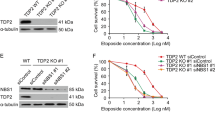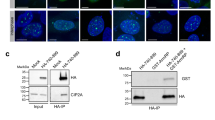Abstract
DNA double-strand breaks (DSB) can arise during DNA replication, or after exposure to DNA-damaging agents, and their correct repair is fundamental for cell survival and genomic stability. Here, we show that the Smc5–Smc6 complex is recruited to DSBs de novo to support their repair by homologous recombination between sister chromatids. In addition, we demonstrate that Smc5–Smc6 is necessary to suppress gross chromosomal rearrangements. Our findings show that the Smc5–Smc6 complex is essential for genome stability as it promotes repair of DSBs by error-free sister-chromatid recombination (SCR), thereby suppressing inappropriate non-sister recombination events.
This is a preview of subscription content, access via your institution
Access options
Subscribe to this journal
Receive 12 print issues and online access
$209.00 per year
only $17.42 per issue
Buy this article
- Purchase on Springer Link
- Instant access to full article PDF
Prices may be subject to local taxes which are calculated during checkout


Similar content being viewed by others
References
Daley, J. M., Palmbos, P. L., Wu, D. & Wilson, T. E. Annu. Rev. Genet. 39, 431–451 (2005).
Pâques, F. & Haber, J. E. Microbiol. Mol. Biol. Rev. 63, 349–404 (1999).
Kadyk, L. C. & Hartwell, L. H. Genetics 132, 387–402 (1992).
Lehmann, A. R. et al. Mol. Cell Biol. 15, 7067–7080 (1995).
Torres-Rosell, J. et al. Nature Cell Biol. 7, 412–419 (2005).
Strathern, J. N. et al. Cell 31, 183–192 (1982).
Haber, J. E. Annu. Rev. Genet. 32, 561–599 (1998).
Moore, J. K. & Haber, J. E. Nature 383, 644–646 (1996).
Valencia, M. et al. Nature 414, 666–669 (2001).
Holmes, A. M. & Haber, J. E. Cell 96, 415–424 (1999).
Gonzalez-Barrera, S., Cortes-Ledesma, F., Wellinger, R. E. & Aguilera, A. Mol. Cell 11, 1661–1671 (2003).
Myung, K., Datta, A., Chen, C. & Kolodner, R. D. Nature Genet. 27, 113–116 (2001).
Ünal, E. et al. Mol. Cell 16, 991–1002 (2004).
Strom, L., Lindroos, H. B., Shirahige, K. & Sjogren, C. Mol. Cell 16, 1003–1015 (2004).
Sjogren, C. & Nasmyth, K. Curr. Biol. 11, 991–995 (2001).
Acknowledgements
We would like to thank H. Yu, R. Potts and C. Sjogren for communicating results before publication. The Medical Research Council UK supported the Aragón laboratory. The Ministerio de Educación y Ciencia, Spain (grant SAF2003-00204) funded work in the Aguilera laboratory. Funding for the Haber laboratory is from the National Institutes of Health (NIH; grant GM20056). F.C.-L. is a fellow from the Fondo de Investigaciones Sanitarias, Spain. G.I. is a Charles A. King Medical Foundation of Boston fellow. S.U. is a Marie Curie Fellow from the EU.
Author information
Authors and Affiliations
Corresponding authors
Ethics declarations
Competing interests
The authors declare no competing financial interests.
Supplementary information
Supplementary Information
Supplementary Figures S1, S2 and Supplementary Materials (PDF 2272 kb)
Rights and permissions
About this article
Cite this article
De Piccoli, G., Cortes-Ledesma, F., Ira, G. et al. Smc5–Smc6 mediate DNA double-strand-break repair by promoting sister-chromatid recombination. Nat Cell Biol 8, 1032–1034 (2006). https://doi.org/10.1038/ncb1466
Received:
Accepted:
Published:
Issue Date:
DOI: https://doi.org/10.1038/ncb1466
This article is cited by
-
Genome control by SMC complexes
Nature Reviews Molecular Cell Biology (2023)
-
Smc5/6 silences episomal transcription by a three-step function
Nature Structural & Molecular Biology (2022)
-
Rpd3L and Hda1 histone deacetylases facilitate repair of broken forks by promoting sister chromatid cohesion
Nature Communications (2019)
-
Interaction of the Saccharomyces cerevisiae RING-domain protein Nse1 with Nse3 and the Smc5/6 complex is required for chromosome replication and stability
Current Genetics (2018)
-
Specialized interfaces of Smc5/6 control hinge stability and DNA association
Nature Communications (2017)



